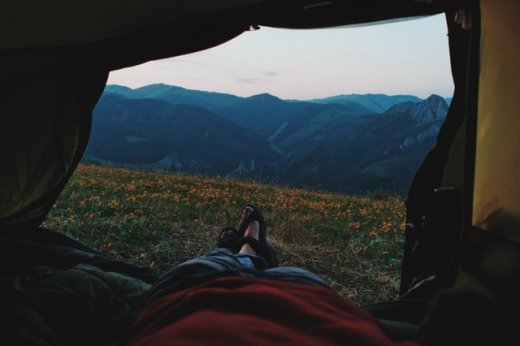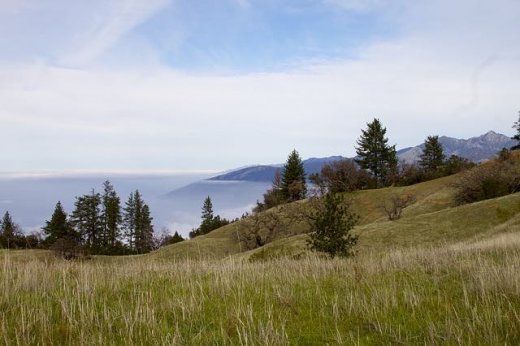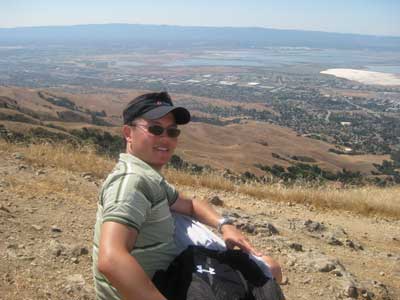
Whether you’re camping, backpacking or going for a short hiking trail for more than a day, finding the right spot for sleeping is essential for your night out in the wild. However, you may not always find a suitable spot – a nice flat ground, to pitch your tent for a goodnight’s sleep. In that case, seasoned campers and hikers recommend sleeping on a slight incline with your head on the uphill side.
So, how steep of a hill can you sleep on and which is the best sleeping position that won’t have you roll down or waking up with a migraine? If you cannot find level ground, a hillside can also make a perfect sleeping ground as long as it’s not that steep. To protect yourself from sliding or rolling over, you’ll need to set up close to a tree, large rock, log, or improvise anything that can be placed on the downhill side of the sleeping pad to slightly level the surface.
This article will cover the following topics:
- Is It Better to Sleep Uphill or Downhill?
- Are There Negative Health Effects When Sleeping On A Steep Hill?
- What Degree of Slope Is Considered Steep?
- Tips for Sleeping On An Incline
To learn more about how you can comfortably sleep on a relatively steep hillside – and the health effects of sleeping on a hillside – read on.
Is It Better to Sleep Uphill or Downhill?

Though humans are used to sleeping on a flat surface and have become a norm, there’s no evidence or logical reason to support why that should be the case – given that the in the animal kingdom things are different.
So is it better to sleep uphill or downhill? Or, do you prefer sleeping unbeveled positions like:
- Uphill – Head towards the upper hill with legs slightly lower
- Downhill – Head towards downhill with legs slightly raised
- Hammock position – Abdomen area towards downhill with legs raised on the same level as the head or slightly higher.
- Torso – The body from the waist upwards is beveled with the legs slightly raised using a pillow, but uphill you can improvise using a rotten log or large rock, or anything that can support your arms and knees.
Sleeping uphill is the most recommended position if you can’t find a flat spot because it reduces the risk of rolling or sliding down the tent, especially when you face the potential of rolling down to a steep drop.
To achieve a perfect uphill sleeping style, you should first make sure your head is positioned in the uphill direction and keep the feet lowered downhill. The best way to achieve this is by positioning your head toward the top of the hill and keeping the feet towards the bottom. You can add pillows and cushions under your feet to keep you from slipping away.
In healthcare, inclined sleeping has also been shown to promote several body functions particularly the brain and spine. However, sleeping downhill is highly discouraged because it’s you not only risking rolling down while sleeping but also waking up with a heavy migraine as a result of blood rushing to your head the entire night.
If you have a steep ground somewhere near your home, you can practice pitching a tent and sleeping uphill to identify your best sleeping position.
Are There Negative Health Effects When Sleeping On A Steep Hill?

From the medical point of view, there are numerous benefits of sleeping in an inclined position from improving the quality of sleep by addressing health problems that affect sleep to treating respiratory ailment and heart conditions among other diseases.
Benefits of Gravity Inclined Sleeping
Improves the Circulation of Blood and Lymph and Detoxification
Gravity inclined sleeping improves the circulation of blood and lymph, allowing your brain to detox quickly through the glymphatic system while sleeping. The force of gravity allows waste and other harmful substances from the peripheral lymphatic system to be excreted easily.
When you sleep, your brain enters an inactive state and starts to shrink. During this time, cerebrospinal fluid washes the brain, removing the buildup of harmful proteins on the synapses, helping to restore oxygen to the brain and improve neural functions.
Improves Mobility, Spine and Body Posture
Sleeping in a gravity inclined position is also known to improve the body structure and help address a range of spine and back problems.
This position alleviates the force of gravity on the body, which helps the spine, body muscles and connective tissues to regenerate and straighten.
Sleeping on a slope can also prevent spine problems related to aging and postural problems associated with muscle weakness, tightness and poor core stability such as scoliosis, kyphosis and lordosis.
Medication-Free Treatment for Sleeping Disorder Breathing
Obstructive sleep apnea is a potentially serious disorder that not only disrupts quality sleep but increases the risk of contracting other health conditions like heart complications, diabetes and high blood pressure.
The condition is characterized by several symptoms including restless sleep, morning headaches, choking sensation, sleepiness during the day and exhaustion, snoring among others. Depending on the type of apnea, the symptoms could greatly vary from mild to severe with serious health complications.
Sleeping elevated improves your breathing by opening the airway to allow maximum flow of oxygen into the blood. This eliminates snoring, mouth breathing and increases blood oxygen to the brain while preventing acid reflux, heartburn and congestion problems. This position allows you to breathe and sleep better.
Relieve Sinus Pressure and Head Congestion
Sleeping on an incline is also an effective way of eliminating nasal congestion and sinus pressure because it helps to unblock the sinus drainage responsible for draining mucus from the head. When the drainage is blocked, sinus glands continue to produce mucus, which builds up in the head.
Sinus congestion causes breathing difficulty at night and potential morning headaches. By sleeping elevated you allow the mucus to drain easily through the sinus, stopping mouth breathing and encouraging better sleep.
One of the effects of lying flat is that too much pressure is exerted on the head, which causes an insufficient supply of oxygen and sugar in the brain. The blood vessels on the brain vasodilate and increase blood flow and pressure that work extra hard to flush out toxins from the brain.
That process of brain flushing toxins with inadequate oxygen is what results in painful migraine headaches. This problem can be easily solved by sleeping on a slope with the head slightly raised.
If it’s your first time sleeping elevated, the feeling can be weird. However, with time, you’ll adjust and find it even more comfortable than lying flat.
What Degree of Slope Is Considered Steep?

The best way to determine how steep a slope of an area is by measuring the change in elevation over a horizontal distance of 100m, and get the slope percentage.
To know what degree of slope is considered steep, you need to first understand the characteristics of slopes and the differences, which include:
- Angle
- Aspect
- Course of the fall line
- Shape
Angle
The angle of a slope is often measured in degrees instead of percentages, and the measurement can be taken while on the slope using mobile applications or a contour map.
Knowing the angle of a slope is particularly important for campers, and hikers looking for a place to pitch tents, as well as skiers and snowboarders on the quest of finding a perfect avalanche terrain. This data helps them to understand how steep a slope is and understand the terrain better.
As mentioned above, the recommended measuring unit of angle is degrees: The higher the degree the steeper a slope is.
- 30 degrees – This is an average steep slope
- 30 and 35 degrees – The slope is steep
- 35 and 40 degrees – The slope is very steep
- A slope with more than 40 degrees is considered extremely steep.
So, it’s true to say that at 30 and 35 degrees, that’s when a slope is considered to be steep. When taking your measurements, whether you’re using an app, map or a slope measuring device, it’s advised to measure the steepest part of the slope to get an accurate angle.
Aspect
The slope aspect refers to the compass direction a physical slope faces. This is another key difference between slopes and it can be determined using a compass, contour map or using the conventional way of sun and time.
Aspect directions are classified according to the angle of slope, which are under different classes.
How do you take slope measurements using a compass?
- Stand upright with you back facing the slope
- Steadily hold the compass with the display facing up, parallel to the ground
- Then point the compass down slope and wait for the ‘N’ to settle pointing the north direction
- Read the direction to know the aspect of your slope
Taking slope measurements using sun and time
Using the traditional sun and time method you can also determine the aspect of a slope. But how do you do that?
- First, we know that the sun rises and sets in the east and west respectively.
- The sun reaches its highest point at the south
- In some areas, the sun will attain its highest point at noon while on others it will reach later in the day.
- During the daylight, the sun reaches its highest point at around 1 pm.
With this in mind, you just need to locate where the sun is, check the time of the day and sight down the slope.
Taking slope measurements using a contour map
From a geography class, you are taught that the highest point of the map represents the north direction. With that knowledge in mind, you easily determine the aspect of the slopes. A contour map can also help you determine the elevation angle, the distance between points, as well as identify hills and valleys.
This article is owned by Recapture Nature and was first published on April 9, 2020
Fall Line
Another characteristic of slopes is the fall line. Also referred to as the direction of the slope, the fall line is basically where the slope angle is derived. It defines the shortest route across the steep.
The shape of the slope
The shape of a slope is based on its gradient and there are two types of slopes, convex and concave. A convex slope is steeper at the fall line while a concave slope becomes steeper uphill, which is represented with close contour lines on a map.
Tips for Sleeping On An Incline

Sleeping in an inclined position is a new phenomenon and it’s slowly catching up due to its numerous health benefits. This position enhances the interaction between gravity and the brain.
But how do you sleep on an incline? Well, first, this depends on whether you have an already customized inclined bed or adjusting your bed for that position using bed risers. If you choose to buy one, there are great options out there with some specially built for gravity inclined bed therapy.
What are some of the things to look for when choosing an inclined bed?
This article is owned by Recapture Nature and was first published on April 9, 2020
- The slope degree from the end of the headboard to the footboard.
- The drop from the headboard to the footboard
- Adjustable frames
- Ability to fit different size of mattress
- Raised foot board to protect the mattress sliding or moving unnecessarily
If you’ll be adjusting your bed, to raise the head of the bed for an incline sleeping position, there are multiple products you can use to achieve that. From adjustable bed risers and bed wedges to adding pillows, inflatable mattress topper and box spring.
Bed risers are an inexpensive alternative to achieving an inclining sleeping position than buying a new bed. Though they’re not as secure, there are heavy-duty options that are secure and durable.
Using bed risers to adjust the height of your bed for a proper incline sleeping position.
- Elevate the head of your bed to at least 6 inches to prevent snoring, breathing from the mouth, sleep apnea, heart congestion and acid reflux, among other sleeping disorders. The idea is to achieve a perfect elevation, so try using small bed risers as you upgrade to the desired angle.
- Use specially designed bed risers that have non-slip bases to prevent the bed from moving and potentially collapsing. Bed risers feature depressions where foam inserts are added to adjust the height of the headboard.
- Choose solid wood, heavy-duty metal or plastic risers with depressions. Some options will lack foam inserts, but only consider bed risers with recesses wor wells to prevent the bed feet from slipping.
- You can also improvise using thick books, cement, or wood blocks though these options cannot guarantee safety, as much as they are functional.
Alternatively, you can buy a wedge pillow or mattress pads that will raise your head, neck, and chest while promoting an incline sleeping position to treat sleep apnea and improve the quality of sleep. Don’t try to use stacks of pillows, otherwise you’ll end up aggravating your condition and cause more harm than good.
Bed wedges are a great alternative to wedge pillows and a suitable option to use with a box spring. Unlike wedge pillows that only raise the chest upwards, bed wedges allow you to attain a proper incline throughout the bed by raising the entire end of the mattress.You might consider an inflatable mattress pad in addition to having an adjustable bed though it’s an expensive option.
This article is owned by Recapture Nature and was first published on April 9, 2020
Final Thoughts
Sleeping in an inclined position can be a challenge at first, but you’ll get used to it. Most people complain of sliding down the bed, especially sleepers who use wedge pillows. The best way to avoid this is by placing large pillows at the footboard to keep you elevated and protect you from sliding down.

